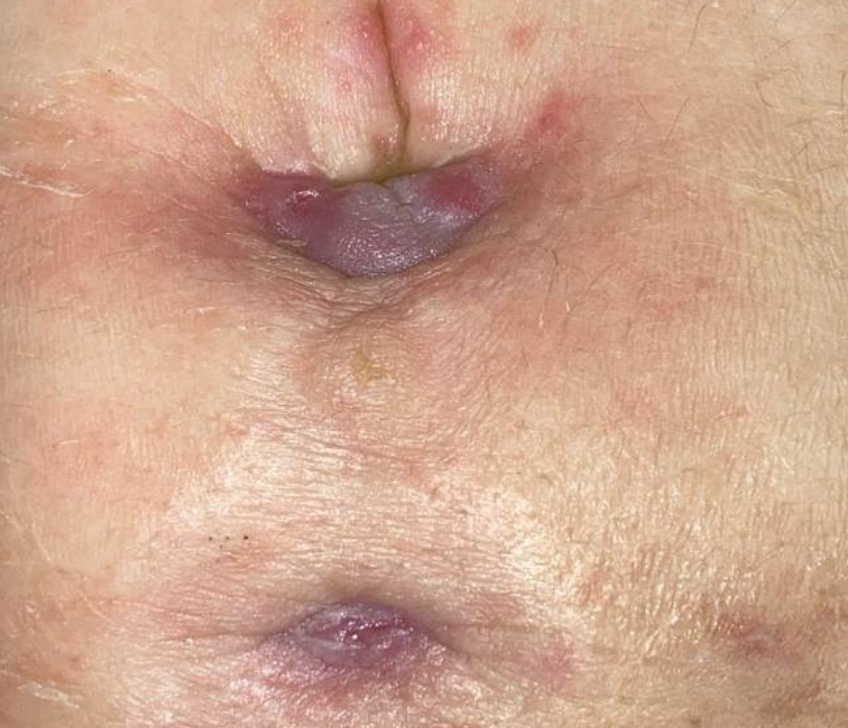Tuesday Poster Session
Category: IBD
P5507 - A Curious Case of Belly Button Drainage - An Unusual Presentation of Crohn’s Disease With Entero-Vesico-Cutaneous Fistula
Tuesday, October 28, 2025
10:30 AM - 4:00 PM PDT
Location: Exhibit Hall
.jpg)
Angelin Raju, MD (she/her/hers)
Texas Health Resources HEB/ Denton
Bedford, TX
Presenting Author(s)
Angelin Raju, MD1, Anish Jomy, MBBS2, Scott Keeney, DO1
1Texas Health Resources HEB/ Denton, Bedford, TX; 2Methodist Health System, Richardson, TX
Introduction: Enterovesical cutaneous fistulae are rare, but serious complications often associated with inflammatory bowel disease (IBD), particularly Crohn’s disease. These fistulae result from chronic inflammation, leading to abnormal connections between the bowel and bladder to skin. This case report highlights diagnostic challenges in a 76-year-old female with a complex presentation of enterovesical cutaneous fistula, initially misdiagnosed as an infected urachal cyst, and ultimately attributed to Crohn’s disease.
Case Description/
Methods: A 76-year-old woman from Puerto Rico with coronary artery disease presented with chronic umbilical drainage, abdominal pain and significant weight loss over two years. The drainage, initially clear, became yellowish and worsened over time. Prior evaluations in Puerto Rico, including endoscopy and colonoscopy, showed gastritis and colonic inflammation but were inconclusive for Crohn’s disease. After relocating to USA, she was hospitalized for further evaluation. A CT scan with oral and IV contrast and cystogram revealed thickened distal ileal loops without evidence of a fistula. However, the drainage fluid had elevated creatinine level (8.4 mg/dL), indicating a urinary source. Cystoscopy revealed purulent drainage from the bladder dome, consistent with an infected urachal cyst. Biopsies were taken and the tract was fulgurated. She was soon readmitted with worsening abdominal pain and increased fistula output with foul smelling. Repeat imaging showed progressive ileocecal inflammation and a visible vesico-cutaneous fistula. Exploratory laparotomy revealed multiple adhesions, small bowel strictures, and bowel adherent to the bladder dome with a cutaneous fistula. She underwent right hemicolectomy, terminal ileum resection, and cystorrhaphy. Pathology confirmed Crohn’s disease. Postoperatively, started on mesalamine and referred to gastroenterology and urology for ongoing care.
Discussion: Crohn’s disease is a chronic inflammatory condition that can affect any part of the gastrointestinal tract, often leading to complications such as strictures and fistulae. Medical therapy with immunomodulators is essential for controlling inflammation, but surgical intervention is often necessary for complications such as strictures or refractory fistulae. This case underscores the importance of considering Crohn’s disease in patients with recurrent fistulae and abdominal symptoms, even in the absence of prior definitive diagnosis regardless of age.

Figure: Entero-Vesico-Cutaneous fistula; skin finding
Disclosures:
Angelin Raju indicated no relevant financial relationships.
Anish Jomy indicated no relevant financial relationships.
Scott Keeney indicated no relevant financial relationships.
Angelin Raju, MD1, Anish Jomy, MBBS2, Scott Keeney, DO1. P5507 - A Curious Case of Belly Button Drainage - An Unusual Presentation of Crohn’s Disease With Entero-Vesico-Cutaneous Fistula, ACG 2025 Annual Scientific Meeting Abstracts. Phoenix, AZ: American College of Gastroenterology.
1Texas Health Resources HEB/ Denton, Bedford, TX; 2Methodist Health System, Richardson, TX
Introduction: Enterovesical cutaneous fistulae are rare, but serious complications often associated with inflammatory bowel disease (IBD), particularly Crohn’s disease. These fistulae result from chronic inflammation, leading to abnormal connections between the bowel and bladder to skin. This case report highlights diagnostic challenges in a 76-year-old female with a complex presentation of enterovesical cutaneous fistula, initially misdiagnosed as an infected urachal cyst, and ultimately attributed to Crohn’s disease.
Case Description/
Methods: A 76-year-old woman from Puerto Rico with coronary artery disease presented with chronic umbilical drainage, abdominal pain and significant weight loss over two years. The drainage, initially clear, became yellowish and worsened over time. Prior evaluations in Puerto Rico, including endoscopy and colonoscopy, showed gastritis and colonic inflammation but were inconclusive for Crohn’s disease. After relocating to USA, she was hospitalized for further evaluation. A CT scan with oral and IV contrast and cystogram revealed thickened distal ileal loops without evidence of a fistula. However, the drainage fluid had elevated creatinine level (8.4 mg/dL), indicating a urinary source. Cystoscopy revealed purulent drainage from the bladder dome, consistent with an infected urachal cyst. Biopsies were taken and the tract was fulgurated. She was soon readmitted with worsening abdominal pain and increased fistula output with foul smelling. Repeat imaging showed progressive ileocecal inflammation and a visible vesico-cutaneous fistula. Exploratory laparotomy revealed multiple adhesions, small bowel strictures, and bowel adherent to the bladder dome with a cutaneous fistula. She underwent right hemicolectomy, terminal ileum resection, and cystorrhaphy. Pathology confirmed Crohn’s disease. Postoperatively, started on mesalamine and referred to gastroenterology and urology for ongoing care.
Discussion: Crohn’s disease is a chronic inflammatory condition that can affect any part of the gastrointestinal tract, often leading to complications such as strictures and fistulae. Medical therapy with immunomodulators is essential for controlling inflammation, but surgical intervention is often necessary for complications such as strictures or refractory fistulae. This case underscores the importance of considering Crohn’s disease in patients with recurrent fistulae and abdominal symptoms, even in the absence of prior definitive diagnosis regardless of age.

Figure: Entero-Vesico-Cutaneous fistula; skin finding
Disclosures:
Angelin Raju indicated no relevant financial relationships.
Anish Jomy indicated no relevant financial relationships.
Scott Keeney indicated no relevant financial relationships.
Angelin Raju, MD1, Anish Jomy, MBBS2, Scott Keeney, DO1. P5507 - A Curious Case of Belly Button Drainage - An Unusual Presentation of Crohn’s Disease With Entero-Vesico-Cutaneous Fistula, ACG 2025 Annual Scientific Meeting Abstracts. Phoenix, AZ: American College of Gastroenterology.
